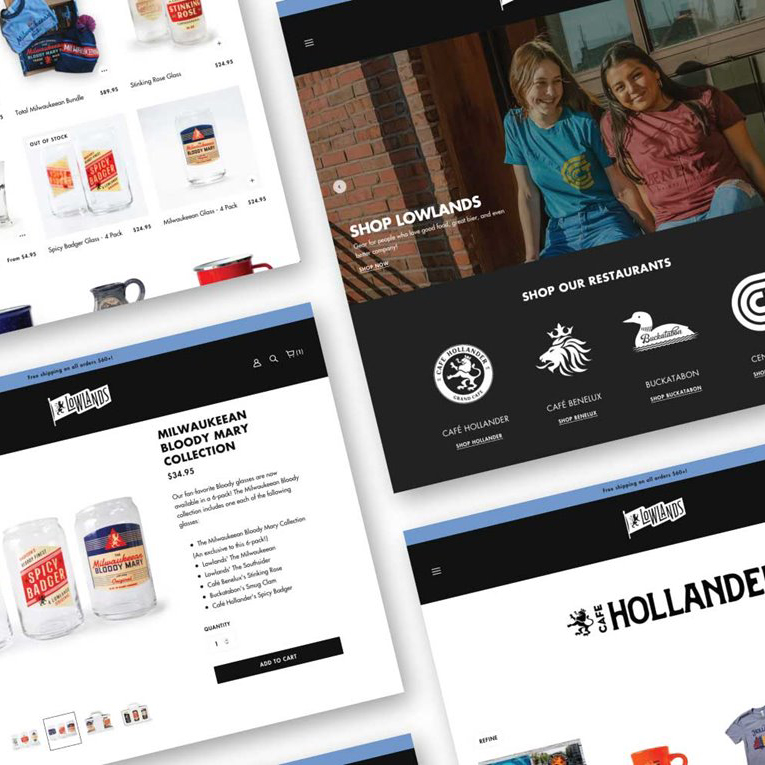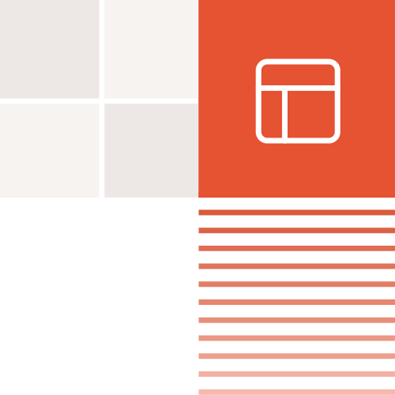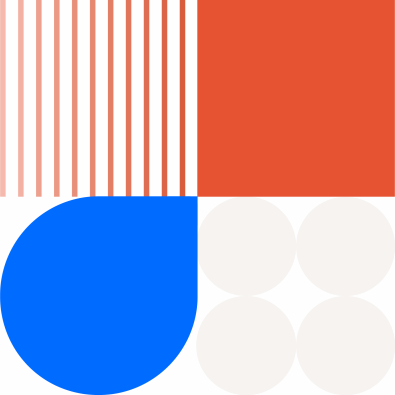Today, we're talking to one of our food and beverage clients about selling swag online. From t-shirts to gift cards, restaurants have evolved from local eateries to brand-name business groups. To tell their story. I've invited Sam Schulte, the marketing specialist for the Lowlands Group, to discuss how their migration from WooCommerce to Shopify helped increase sales by 9% in just 2-months (and it's not even their busy season).
Today’s Topics:
- A little about the Lowlands Group
- Re-platforming their store from WooCommerce to Shopify
- Learning and leveraging pre-existing themes
- Customizing templates where it matters (keep it simple)
- Creating better checks and balances between product owners
- Creating a dynamic navigation for each restaurant
- Tracking sales, promotions, and product interest
- Analyzing the monetary impact of the new shop
- Trusting in your digital partner
Subscribe
LOOK & LISTEN
Welcome to Beyond the Cart presented by Lightburn. This is a podcast all about ecommerce, where we share some of our experiences building, managing, and promoting direct-to-consumer brands. I'm Nora. And today we're talking to one of our food and Bev clients about selling swag online. From t-shirts to gift cards, restaurants have evolved from local eateries to brand-name businesses. To tell their story, I've invited Sam Schulte, the marketing specialist for the Lowlands Group.
Welcome Sam. Hi, thank you So, much for having me today. I'm really excited to make my podcast debut. I know we're excited to have you, why don't you tell me a little bit about your role at Lowlands Group and for those who don't know, you know, who Lowlands Group is?
A little about the Lowlands Group Restaurants
Yeah. So, Lowlands Group is a Milwaukee-based restaurant group. We have seven Milwaukee area locations and then one location in Madison, Wisconsin, and we have four different brands plus the Lowlands Group brand, which is kind of just the umbrella. My role in the Lowlands Group is marketing specialists with kind of more of a focus on the digital aspects. So, I'm heavy on the website, social media, email marketing, those kind of things are probably my three main points. Yeah.
You have a hand in a lot of things. Yep. In your role. We were talking about that earlier. So, I've known Lowlands Group for ages long before you were a client of ours. And like you said, each location kind of has its own feel, but there's that umbrella brand. Do you have like an elevator pitch of like who lowlands is? Like what the, the vibe is overall?
Yeah. So, we're inspired by the Europeans specifically the Benelux region. So, Belgium, Netherlands, and Luxembourg, how they kind of embrace their culture with grand cafes and beer and bikes. So, we're really inspired. Those are kind of like the three big wheelhouses and everything stems out from there.
Cool. Yeah, I think it's very, it's a very clear brand. When you walk into one of your restaurants, it feels really comprehensive. And that was certainly what we were trying to do.
Re-platforming their shop from WooCommerce to Shopify
Re-platformed all of your sites, including the corporate site, part of that was ecommerce which isn't the main focus of what you're doing. So, what, what are you selling on the ecommerce shop?
So, our ecommerce shop has t-shirts sweatshirts, all different kinds of apparel, hats. We also, have glassware, some of our famous Milwaukee and bloody Mary glasses are sold on there. And it's something we're really hoping to expand in the coming years. Just all different kinds of gifts and swag. And it's a, a fun way to show who we are with the beer bikes, foodie aspect of our brand.
So, when you came to us for the big overhaul of your whole sort of digital ecosystem, ecommerce, wasn't like the leading force, but it definitely needed to be included. So, you were on WooCommerce when, when we start working together. Tell me a little bit about what, you know, what you were getting out of your ecommerce platform before we started working together.
Yeah. So, our ecommerce platform was just outdated. There was no way to filter any of the products. You couldn't sort them by restaurant concept. You couldn't sort them by category, you know, t-shirts versus glassware. And it was just a page on our website. There was no way to navigate to the other shop pages. Once you clicked on a product, you just kind of had to start everything over. So, we were really getting the basics out of our ecommerce store. Like somebody could go, they could purchase something and that was about it. So, we knew it would need to be redone at some point, but it, it definitely, yeah, it wasn't our main focus. Once we started working together, but the ways that it's kind of played out and helped us has ended up being, showing us that it's a bigger portion than we ever could have thought.
One of the first steps we took was figuring out a platform for you. What was that process like to pick the platform in the first place?
Yeah. So, Stacy has been in immense help and as a guide and just kind of explaining our different options and helping us navigate through those decisions throughout this whole project, but specifically with the ecommerce she kind of laid it out for us. So, we had WooCommerce, which we were familiar with, but it wasn't really providing everything we were looking for. And then we also, she presented us with the option of Shopify, which we had no prior knowledge of, none of us have ever worked in Shopify before, but she did a really good job of laying out all the different options that we had rather than kind of steering us towards Shopify. But once the pros and cons were all presented, it, it was pretty clear to us that Shopify was the way we wanted to go. Just with the amount of tools and customization and analytics they offered. So, she was really helpful in providing that decision and then kind of walking our team through, after we made the decision to build on Shopify, given that we had had no prior knowledge to the platform.
Learning and leveraging pre-existing themes
Yeah. What, what do you think when you were looking at those pros and cons, what was, was there one deciding factor or anything that stands out to you? So, the big one for us was Shopify. You have to pay, It is extra cost, whereas Where woo commerce is a free plugin, but the things we were paying for were customization, ease of use, good user interface for the customer, good UX on the back end analytics provided after the sale. And just being able to connect that different social media platforms, like all those kind of things. So, it, it really, it was such a long list that it, it wasn't really comparable when we decided.
Yeah. So, like not one thing, but just like a, just overall stronger opportunity. Yes. So, now there, instead of there being kind of this add on to your corporate WordPress site, we're linking people off to a Shopify site that standalone it's not the front door to your brand. That's how I kind of think of it. Like e-commerce, if all we're doing is selling online, then you want that to be the front door. The shop landing page is your homepage, but in this case, it's not the front door. People already know you when they're ending up here. And So, we used a theme that already existed and we picked one that we felt had the features that you needed. And So, that kind of limited design, we, we were working within some design constraints. Mm-Hmm did that ever feel like a negative? Did you ever feel like that was holding you back in any way?
Customizing templates where it matters (keep it simple)
Never the theme we chose has So, many options that we're still able to customize with our own imagery and our own colors, and we were even able to choose a text. So, that was never limiting for us. And there were even some things that your team had coded within the theme to change. Like when you click on a product, it had a massive image for every mm-hmm a alternate image and your team was able to code that. So, that it's more of a smaller gallery with, like a more traditional gallery style. Yeah. So, that actually leads, you mentioned the flat lay photos, So, you're taking your own photos. Yes. Yeah. So, can you talk a little bit about who's working within the store? Like who's interfacing with Shopify on your end?
Creating better checks and balances between product owners
So, in Shopify it is a pretty even split between myself and our merchandise manager. Ashley, Ashley obviously does all of the sourcing of the merchandise and inventory and order fulfillment, and then all help out with the photos kind of building out the front end of the site with the different and banner options. So, we kind of have that split between the two of us. And that actually is another benefit. The fact that Shopify is separate. So, in the future, as our team grows and we onboard a few more people into the shop, we're able to keep that separate rather than having all these people going into the, the website and having to navigate around there just for that, that security component.
Yeah. and, and it just kind of, even if you feel comfortable, you know, using interfaces like this, like I think just having your sort of narrow view of what you're working on, if that's all you have to touch, right. It's just easier for someone who's doing all these other things. Like, it sounds like Ashley has a lot of other responsibilities outside of the ecommerce. Yeah. Most definitely. And it, it plays to both of our strengths too, in what we do well. Was there anything that surprised you when we were working on this project?
I guess the most surprising thing is how easy the learning curve is for Shopify. You know, we were a little nervous going into a system, a platform that we have never used before. And just figuring out how the workflow goes within that. And Stacy, the project manager had sat down with us and kind of walked us through everything. And after that, it it's just been So, intuitive that we're really not limited in any way, shape or form.
Yeah, that's great. Because I know one of the points of the project when we first started was that we were re-platforming within WordPress for all your other sites, because that was familiar. Mm-Hmm So, it's not surprising that that was maybe like a hesitation that you had, So, I'm really glad to hear that it wasn't. Yeah. So, circling back to actually selling swag online, what any, anything that we've done that stands out to you just in the way that the site is organized or how it functions for the end user.
Creating a dynamic navigation for each restaurant
Yeah. So, your team actually was really helpful in coming up with a solution for us to integrate the shop onto each individual restaurant's website. So, we were able to create collections for each restaurant. So, we have the Café Beneluxcollection, Café Hollander, Buckatabon, and then Centraal. So, on those individual websites, there's actually a, a shop section. And when that links, it links to that collection. So, if I go into Buckatabon and I see a shirt that I really love, but they don't have my size, you know, the staff is like, oh, well, you can go online, blah, blah, blah. They go to the website, they click on shop and it takes some specifically to the Buckatabon merch. But they're still on the store… So, they can, you know, click around and see some other things if they're curious and wanna look at at some other stuff, but at least that they're seeing what they kind of came there. Yeah. Specifically to look at. Because a problem we had with our old ecommerce shop was we weren't able to sort anything. So, you just get the long laundry list of all the products. So, if I'm going there to look for a specific t-shirt and it's on page seven of eight, you know, I'm, I'm probably not gonna get there.
Yeah. You know, once they're on the site, they can go anywhere from there, but at least hopefully right away, they're seeing what they came to look for. Yeah. Which Is pretty awesome. Yeah. And another thing that you mentioned earlier, either earlier when we were recording, or maybe earlier this morning was the, the analytics. Yeah. And how easy that is. Can you talk a little bit about what you're keeping track of now that you couldn't before?
Tracking sales, promotions, and product interest
Yeah. So, before we had a couple analytics that we were able to keep track of obviously sale number, average order value I think we could see, you know, whether a customer was new or returning, but now those are like three of a hundred, maybe more analytics that we're able to look at. So, that's been really fun specifically for me. I like to go in and look at what percentage of people are coming onto the site from Facebook and Instagram. And then even within that, who's buying from Facebook and Instagram. And are they clicking onto the store or are they literally on the shop that we set up through Facebook and Instagram? So, that's been really helpful to look at and kind of fun to look at. It also, kind of points me in the next direction of, okay, this shirt has sold 17 times from an Instagram post. Should I post it again? Because I know people like it, or maybe I'll post a picture of someone wearing a shirt that hasn't been sold yet and see if that pushes some drive on that product. Yeah. So, that's been a really cool analytic to look at. We also, we've done a couple discounts and promotions. We, I think maybe we used to have the ability to do a coupon code, but there was no way to look at the analytics after. The fact really. Yeah. Oh my gosh. So, it's kind of, it's kind of pointless. Like we don't wanna run a sale if we don't know, again, like we could look into that ourselves, but… it's a lot. Yeah.
You probably dig through the orders and like manually right. Do that comparison. But… It's a waste of, like we said, that's Not your Main Yeah. It's not your main job. Yeah. And So, we are never gonna sit back and be like, I'm gonna dig into all of this data, but now it's like at your fingertips. Right. So, anything surprising come out of all of that data.
Analyzing the monetary impact of the new shop
So, we launched our site in mid or our new shop we launched in mid-March and just looking from mid-March to mid-July we've already had a 9.5% increase in overall sales. We've had an 8% increase in AOV. We have seen a lot of actual merchandise, like the swag being ordered, whether that's in a, in individual order or tagged on to a, a gift card order. Whereas a lot of our old sales were mainly gift cards.
Yeah. So, just gift, which makes a lot of sense. Right. Because it's a restaurant group, like that's probably, what's bringing people in. Right. But it's really nice to hear the, that now, like, oh, I'll throw a t-shirt in with that too.
Yeah. And our, our merchandise manager, she comments all the time on, oh my gosh. Like we sold seven sweatshirts in one order, you know, it, it's kind of out of the box orders that we weren't seen before. And that's, you know, March through July, that's nothing in comparison to when we get to October or November, December, January, and people are buying gifts and yeah. Yeah, So, it's just been really cool. And we're excited to see how that grows going into the busy season.
Do you have any like, plans that you feel like maybe you're doing now that you wouldn't have thought of or wouldn't have been able to do on the old shop? Something that I've loved. That's kind of fun. We've done a couple of photo shoots just because we have the ability to plug in some really awesome imagery across our new shop. So, we've got some awesome lowlanders from the stores and they have helped us out and modeled some of our merch. And we've had a lot of fun doing that and it's like a good team building opportunity, but then it's also awesome because we can plug in those pictures on the website, we can use them on social media and it that's something we, we never even considered before because it's just like, oh, well, we wouldn't have anywhere to put that on the, the shop.
So, yeah. So, why would you, and now it's like creating this content that you can use yeah. You know, across platforms and that's really cool. Yeah. It's really easy. Like once you get started on something like that, it's like, oh, we could do this too, or right. You know, like it makes it easier to imagine what it could be.
Yeah. And it's the fun part of our job. So, yeah. Yeah. More of that please. Yeah. well, and like, we were really excited because we, I know Stacy worked with you to come up with like what the promotion would be outta the gate to day one when the store launched, but then to see you continuing to add and change things. Like we were looking at it when we first invited you to come on the podcast, Stacey and I were just looking through the store and she was like, oh, they added this section. They, and you're really like managing it. And again, it's not your like number one priority, but the fact that you're doing that and keeping it fresh just makes us feel So, good that we gave you the tools to do that. Yeah. In a way that's easy enough to see it through. So, thank you for, for like cultivating this thing. Yeah. Okay. One, one last question for you. And I, I don't wanna put you on the spot, but do you have any advice or words of wisdom for someone who's embarking on a similar project?
Trusting in your digital partner
I think just letting the team you're working with and the project manager know, you know, these are the problems we're trying to solve and kind of letting them come up or all of you come up with the different solutions and then really weighing out your options for how each one works with the problem you're having. Because I think that was the, the biggest and most important part of this ecommerce project was deciding where we wanted to go with it because had we gone with ecommerce, it would have been fine, but it would've drastically changed the outcome and our productivity since then and how we're able to navigate on the back end. So, yeah, I think just keeping open communication lines and making sure that if you have questions or if that doesn't exactly solve the problem, you're looking for, just speak up about it So, that you're able to figure out a solution because there probably is one that covers everything you're looking to fix.
Yeah. That's great advice. And I hope all of our clients feel like they can do that yeah. With us. And you certainly have, and I, I have to say Stacy has always been So, complimentary about working with you and the whole team at Leland's group across, you know, beyond just the ecommerce site. Mm-Hmm, , it's been, you know, a, a big project to do all of these sites kind of on top of each other while still maintaining their own look and feel. And it's just been a pleasure to work on and we're really proud of the work. So, yeah. Thank you. For, it's been a really smooth ride So, far. Yeah. it has like knock on one. We got one more site. Yeah. As of this recording, but yeah, it's been a pleasure and it's been a pleasure to have you on the podcast today.
Thanks So, much. Yeah. Thank you.
- - - - - -
Beyond the Cart is produced by Lightburn. Our episode today was produced and edited by our very own Staci Tischer and it was recorded in person for the very first time with our pal Ray Fister at 5th Floor Recording Company.
Our music is the song Let's Go Go Go by Tigerblood Jewel. Be sure to subscribe on Apple Podcasts or wherever you consume your audio, and you can always learn more about ecommerce at lightburn.co.
We'll see you next time on Beyond the Cart.



